
Gather up your quarters and get ready to blast some space invaders—we’re headed to the arcade in this speedy roll-and-write game, hoping for a chance to punch in your initials for a high score.
What Is Retrograde?
Retrograde is a roll-and-write game for 1 to 4 players, ages 8 and up, and takes about 30 minutes to play. It’s currently seeking funding on Kickstarter, with a pledge level of $27 for a copy of the game. (There’s also a $3 print-and-play option, though you won’t get the nifty custom dice.) There is a real-time element to it as players race to roll and re-roll dice, so it may be difficult for players who are younger or have other difficulties with dexterity and mobility.
Retrograde was designed by Mary Flanagan and Max Seidman and published by Resonym, with illustrations by Spring Yu and Ann-Sophie De Steur.
New to Kickstarter? Check out our crowdfunding primer.
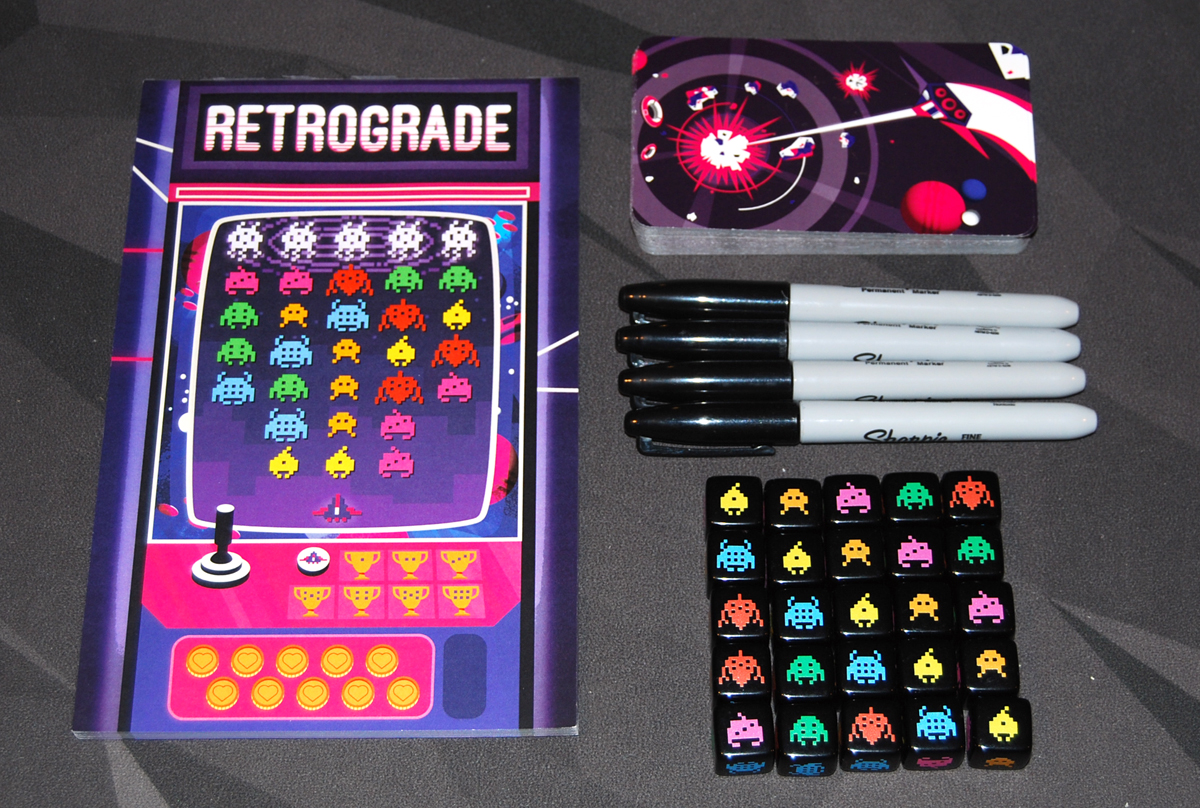
Retrograde Components
Note: My review is based on a prototype copy, so it is subject to change and may not reflect final component quality. For instance, the dice in the final game will actually be etched instead of just printed, and the included markers won’t be Sharpies.
Here’s what will come in the box:
- 100-sheet scorepad—every page is unique!
- 26 custom dice
- 45 Target cards
- 4 markers
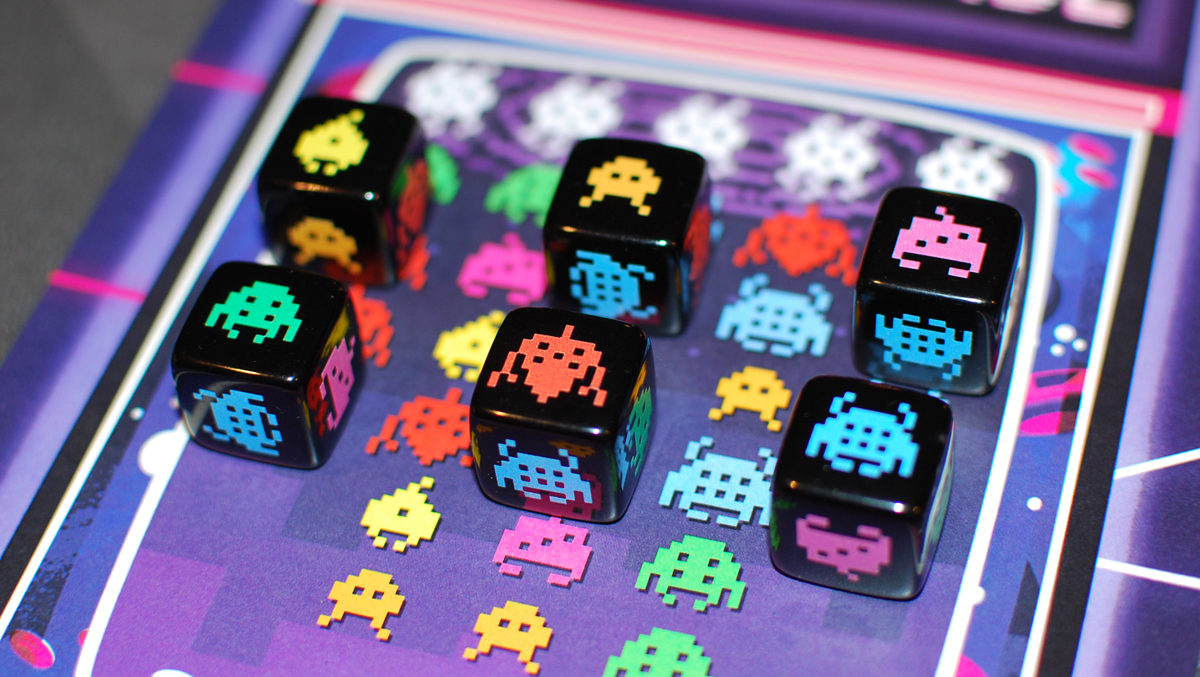
The dice are black, with little pixel-art droids inspired by the old Space Invaders arcade game. There are six droids, and the number of eyes corresponds to the number of pips on each face of the die, so you could even use these dice for any other game that just needs regular six-sided dice. (The droids even have names, like Flan Solo for the 1-pip yellow droid and Foar for the 4-pip green droid.) The dice in the finished game will be etched as well as painted.
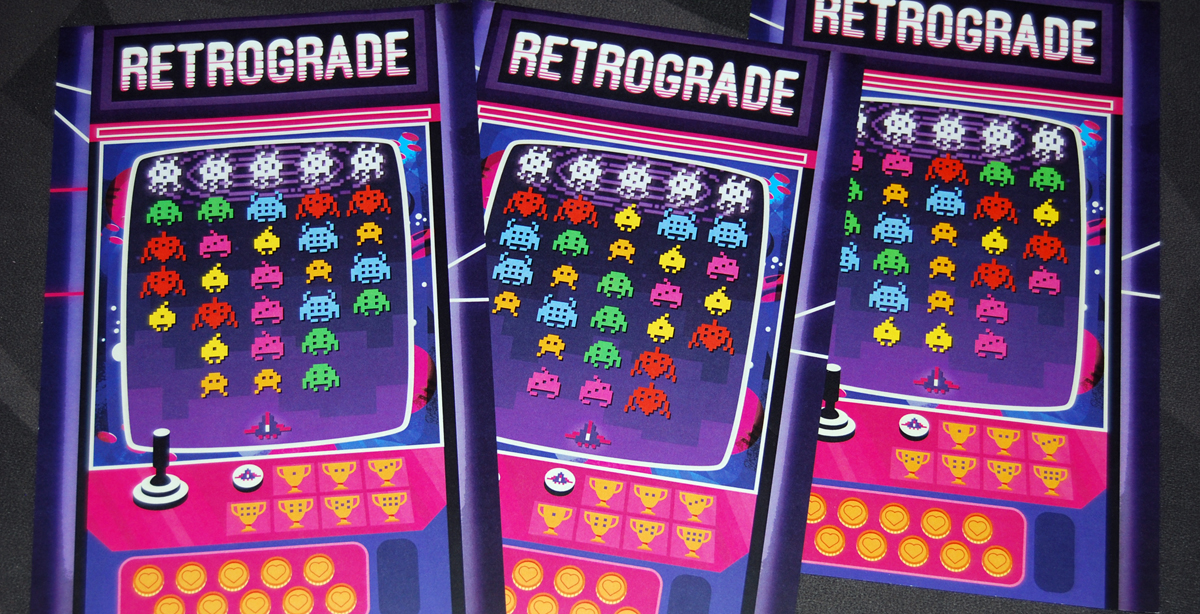
The scoresheet looks like an arcade cabinet, with a “screen” depicting a grid of droids. There are boss droids across the top, and then the rest of the screen is a mix of the six basic droids. One unique aspect about Retrograde is that the sheets are different from each other! While the arrangement is the same, the color combinations are different, which means that players will not always be going for the same color combinations on the target cards.
Below the screen, there are some trophy icons, and then a series of coins at the bottom of the sheet.
How to Play Retrograde
You can download a prototype copy of the rulebook here, and the game is also available to try on Tabletopia, though because there’s a real-time element to it, some players may have more difficulty selecting and rolling dice.
I’ll explain the multiplayer rules first, and then explain the solo variant afterward.
The Goal
The goal of the game is to get the high score, blazing your initials onto the high score chart, by blasting droids and collecting trophies. The game lasts eight rounds.
Setup
Give each player a scoresheet, a marker, and six dice. Shuffle the target cards; you’ll create a deck based on the player count, and then deal out a row of cards, the number of players plus one.
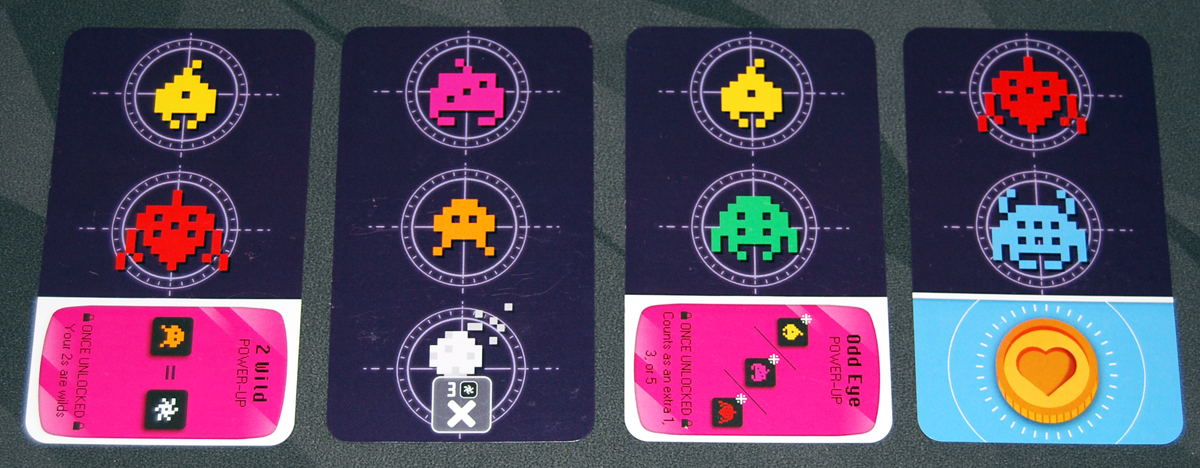
Gameplay
On each round, players get to take a look at the available cards, and once everyone is ready, everyone rolls their dice simultaneously. You may roll and re-roll any number of your dice as many times as you wish, and when you’re happy with the results, you take one of the target cards. If you’re the only person who hasn’t claimed a target card, you only get two more re-rolls, and then you must stop and choose one of the remaining cards.
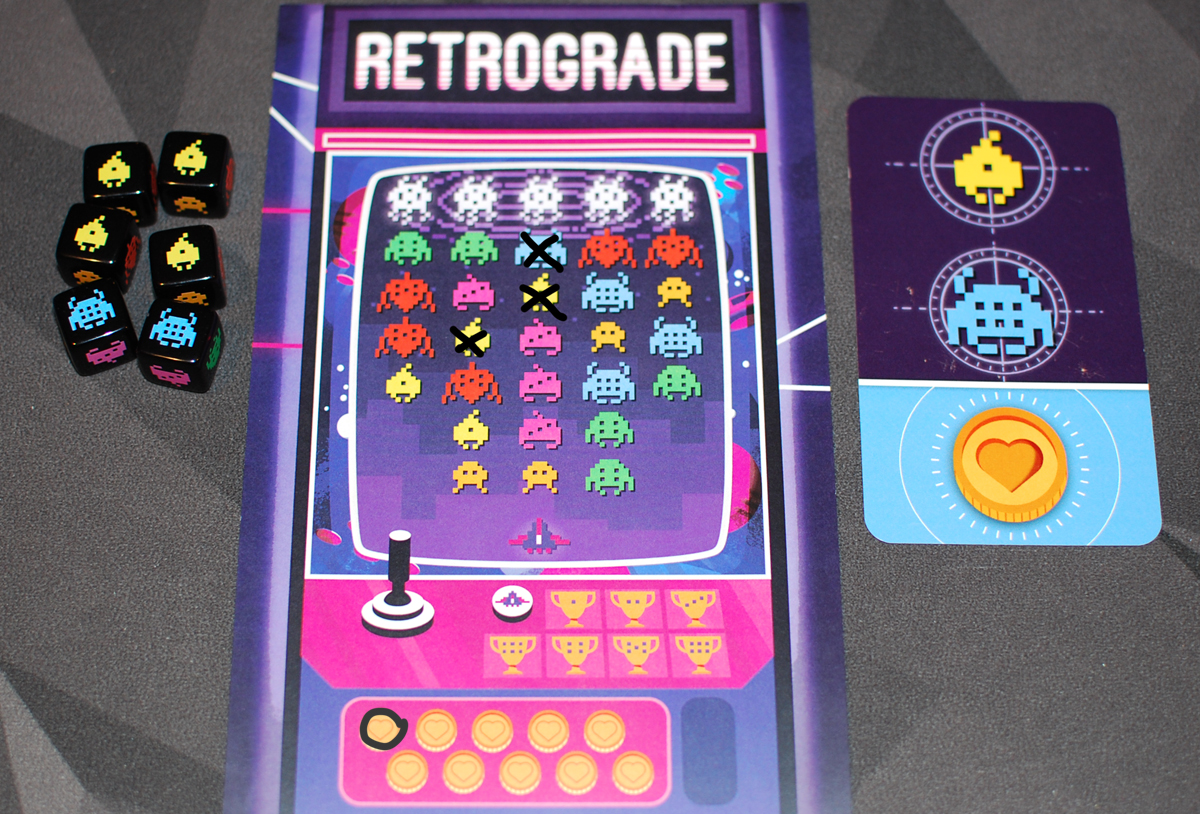
Once everyone has chosen their cards, everyone may spend dice to shoot droids. It takes a pair of dice to shoot the corresponding droid, and there are two other restrictions: first, you may only shoot the droids pictured on your current target card; second, all of the droids you shoot in a single round must be adjacent (orthogonally or diagonally), creating a chain. After blasting droids, you may use one of your leftover dice to circle the corresponding trophy.
Each card shows two droids plus a bonus: a coin, a comet, or a Power-Up. If you took a card with a coin, circle a coin at the bottom of your sheet. In future rounds, you may spend a coin by crossing it out to duplicate one of your dice for that round. If your card has a comet, this round you may use any 3 matching dice to blast any 1 droid, even if it’s not one pictured on your card.
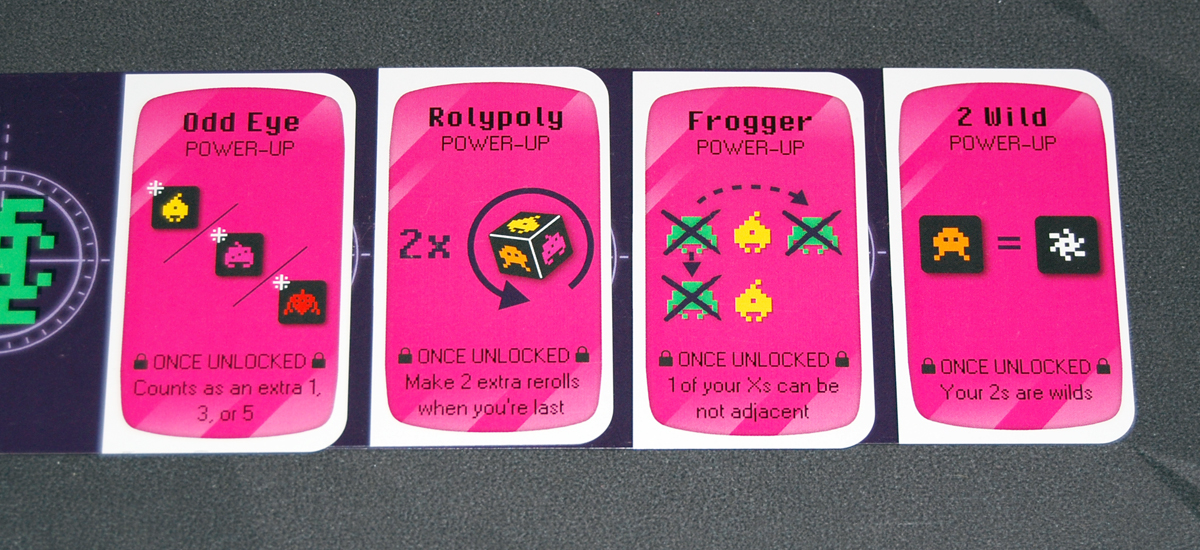
The Power-Ups will grant you bonus ongoing effects such as an extra die, additional re-rolls, and turning certain dice into wilds. However, you must first unlock Power-Ups by eliminating an entire row of droids. For each row you have eliminated, you may tuck one target card under your sheet so that the Power-Up is visible, and then you have that Power-Up for the rest of the game.
At the top of the sheet there are bosses—if you eliminate all of the droids in a column, then you get to cross off the boss as well.
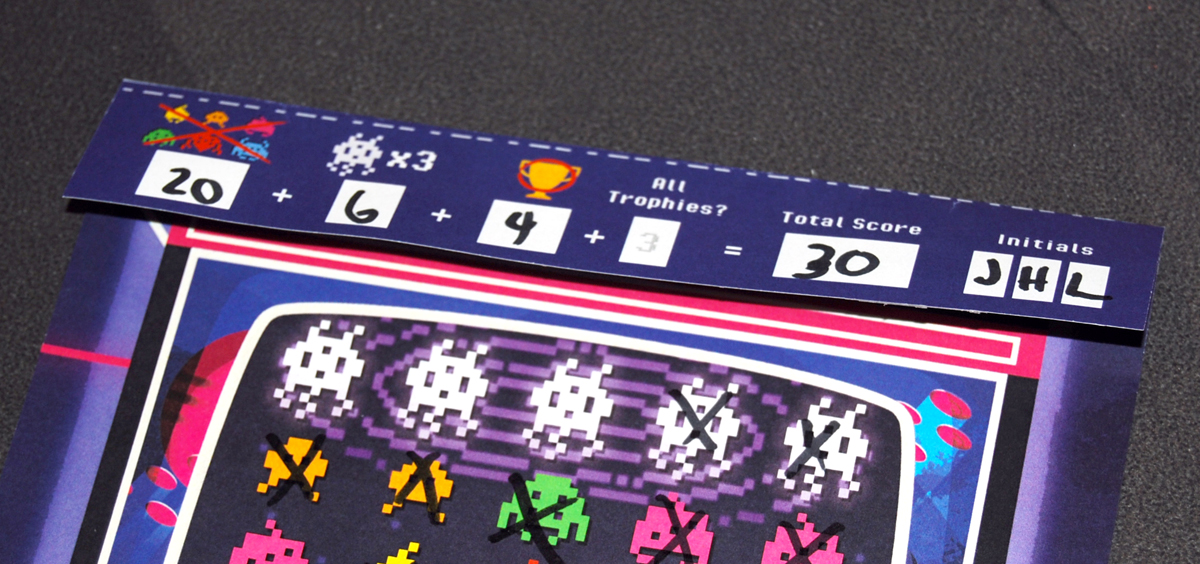
Game End
After the eighth round, there will be no more target cards in the deck, and the game is over.
Scoring is simple! Fold down the top of the sheet, where there’s a flap to calculate your score.
- 1 point per blasted droid
- 3 points per blasted boss
- 1 point per trophy
- 3 bonus points if you earned all of your trophies
Highest score wins, with ties going to the player with the most unspent coins.
Solo Variant
In the solo game, you’re just going for a high score (hoping to achieve 49 points or more).
Set two extra dice off to the side.
The setup will use 4 target cards in the market each round, and before you start rolling dice, you set a timer (on your phone) for 25 seconds but place it so you can’t see the countdown. If you finish rolling before the timer goes off, you take a card and blast droids as usual. However, if the timer goes off, then you roll the two extra dice and remove any cards in the market that have either of those droids. (If all cards are eliminated, then you draw 1 card from the removed cards.) You then get 2 more re-rolls, as if you were the last player, and then claim a card.
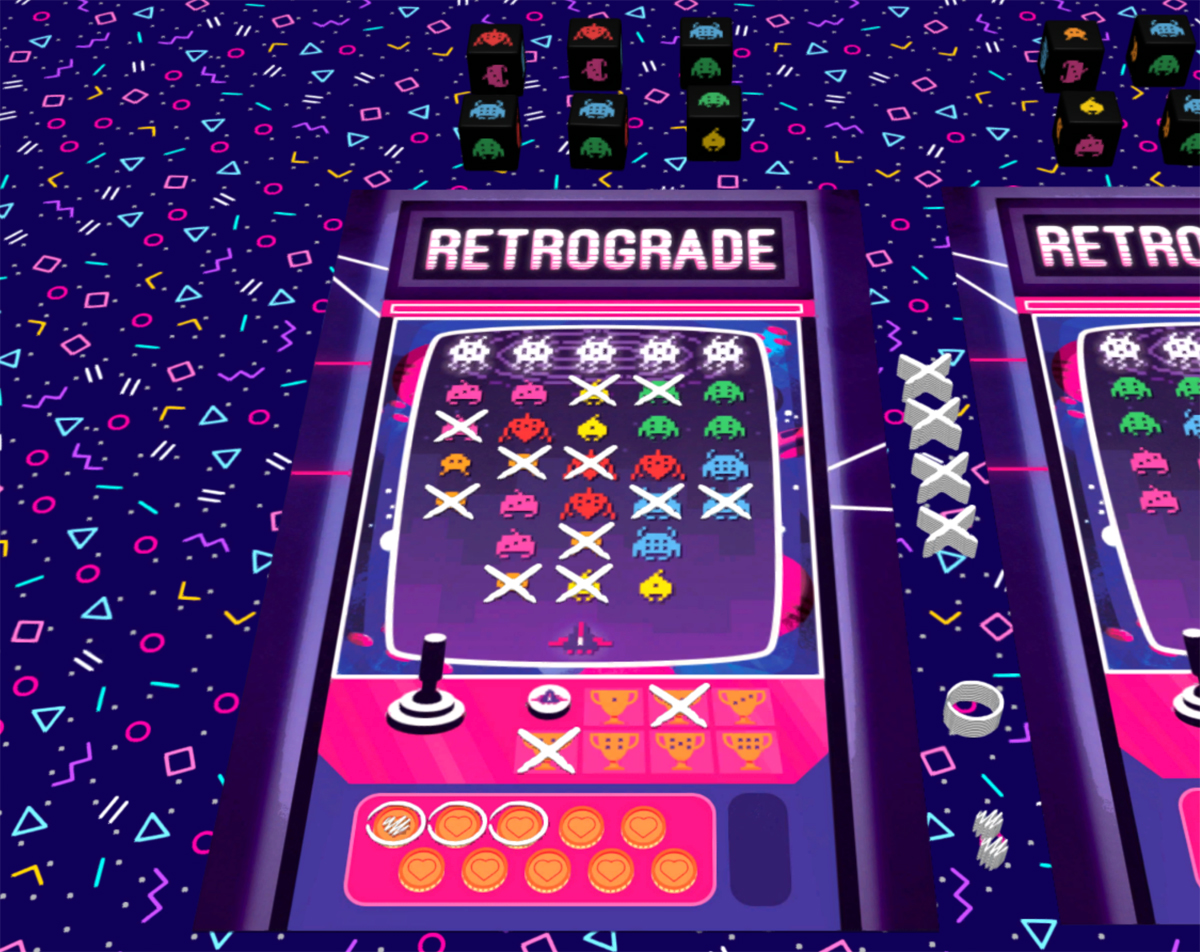
Why You Should Play Retrograde
Retrograde is fast-paced: if you want to guarantee that you get the target card you want, you have to be quick! In the middle of your frantic re-rolling, you may have to decide whether to just grab the card you want even though not all of your dice match, or whether it’s worth a couple extra rolls to get the right dice, at the risk of somebody else taking the card. In some cases, if there aren’t other target cards with the same colors, it may make all of those perfectly matched dice useless!
The power-ups and bonuses on the cards can make a difference, too. Sometimes you’ll want a card simply because the power-up could be really beneficial, even if the droids pictured as targets aren’t the best combination for you. I like that everyone’s sheet has a different arrangement of colors—it changes up which pairs will be more useful for each player.
As the game progresses, though, it can be harder and harder to find combinations that you can use effectively. Maybe you have no more blue droids next to yellow droids; maybe you’ve walled off a section of your sheet that you can no longer cross over to make chains. The other trick, of course, is that you hope to complete columns (for that 3-point boss bonus) or rows (to activate power-ups)—but shooting in straight lines rather than diagonals makes it harder to make future chains.
Many roll-and-writes tend to have a little less player interaction, since everyone shares in the same dice rolls; this one is an interesting twist, since everyone has their own set of dice but you’re competing for the opportunity to take a target card. Even then, there may be times when nobody else is interested in the card you want, so you can take a little more time to get your dice the way you want them. Other times, you’ll want to keep an eye on what dice other players are holding onto, in case it’s time to grab a card or change tactics.
Retrograde is pretty easy to teach and to play. The scoring isn’t complicated, so the challenge is a mix of rolling and thinking quickly, and then deciding how to arrange your Xs so that you can get to the bosses or activate your power-ups. The trophies feel like more of a consolation prize, something you get when you simply can’t make your dice line up with your cards, though maybe somebody will prove me wrong about that.
The solo game works pretty well, and you can easily adjust the difficulty level by shortening or extending the timer. 25 seconds seemed about right to me: it was short enough that I felt the pressure of running out of time, but not so short that I couldn’t finish rolling and take a card some of the time. I haven’t broken the 49-point goal yet, but I did manage a respectable 40 points once.
If you like rolling handfuls of dice and looking for patterns in a field of droids, Retrograde may be worth saving up your quarters for a visit to the arcade. For more information or to make a pledge, visit the Retrograde Kickstarter page!
Click here to see all our tabletop game reviews.
![]() To subscribe to GeekDad’s tabletop gaming coverage, please copy this link and add it to your RSS reader.
To subscribe to GeekDad’s tabletop gaming coverage, please copy this link and add it to your RSS reader.
Disclosure: GeekDad was loaned a prototype of this game for review purposes.
Click through to read all of “Kickstarter Tabletop Alert: Fast-Paced Arcade Action in ‘Retrograde’” at GeekDad.If you value content from GeekDad, please support us via Patreon or use this link to shop at Amazon. Thanks!




